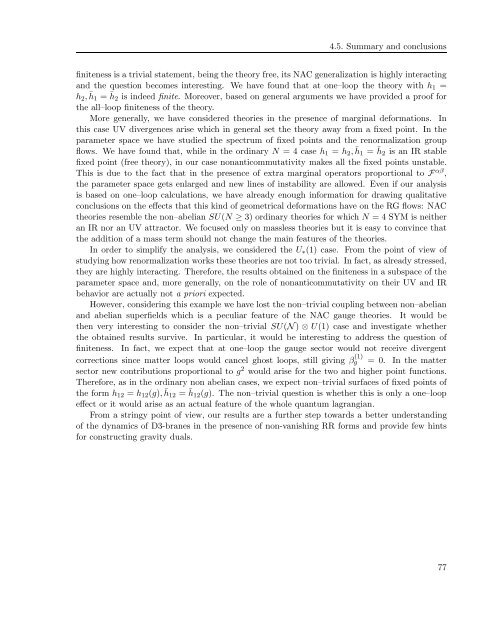Perturbative and non-perturbative infrared behavior of ...
Perturbative and non-perturbative infrared behavior of ...
Perturbative and non-perturbative infrared behavior of ...
You also want an ePaper? Increase the reach of your titles
YUMPU automatically turns print PDFs into web optimized ePapers that Google loves.
4.5. Summary <strong>and</strong> conclusions<br />
finiteness is a trivial statement, being the theory free, its NAC generalization is highly interacting<br />
<strong>and</strong> the question becomes interesting. We have found that at one–loop the theory with h1 =<br />
h2, ¯ h1 = ¯ h2 is indeed finite. Moreover, based on general arguments we have provided a pro<strong>of</strong> for<br />
the all–loop finiteness <strong>of</strong> the theory.<br />
More generally, we have considered theories in the presence <strong>of</strong> marginal deformations. In<br />
this case UV divergences arise which in general set the theory away from a fixed point. In the<br />
parameter space we have studied the spectrum <strong>of</strong> fixed points <strong>and</strong> the renormalization group<br />
flows. We have found that, while in the ordinary N = 4 case h1 = h2, ¯ h1 = ¯ h2 is an IR stable<br />
fixed point (free theory), in our case <strong>non</strong>anticommutativity makes all the fixed points unstable.<br />
This is due to the fact that in the presence <strong>of</strong> extra marginal operators proportional to F αβ ,<br />
the parameter space gets enlarged <strong>and</strong> new lines <strong>of</strong> instability are allowed. Even if our analysis<br />
is based on one–loop calculations, we have already enough information for drawing qualitative<br />
conclusions on the effects that this kind <strong>of</strong> geometrical deformations have on the RG flows: NAC<br />
theories resemble the <strong>non</strong>–abelian SU(N ≥ 3) ordinary theories for which N = 4 SYM is neither<br />
an IR nor an UV attractor. We focused only on massless theories but it is easy to convince that<br />
the addition <strong>of</strong> a mass term should not change the main features <strong>of</strong> the theories.<br />
In order to simplify the analysis, we considered the U∗(1) case. From the point <strong>of</strong> view <strong>of</strong><br />
studying how renormalization works these theories are not too trivial. In fact, as already stressed,<br />
they are highly interacting. Therefore, the results obtained on the finiteness in a subspace <strong>of</strong> the<br />
parameter space <strong>and</strong>, more generally, on the role <strong>of</strong> <strong>non</strong>anticommutativity on their UV <strong>and</strong> IR<br />
<strong>behavior</strong> are actually not a priori expected.<br />
However, considering this example we have lost the <strong>non</strong>–trivial coupling between <strong>non</strong>–abelian<br />
<strong>and</strong> abelian superfields which is a peculiar feature <strong>of</strong> the NAC gauge theories. It would be<br />
then very interesting to consider the <strong>non</strong>–trivial SU(N) ⊗ U(1) case <strong>and</strong> investigate whether<br />
the obtained results survive. In particular, it would be interesting to address the question <strong>of</strong><br />
finiteness. In fact, we expect that at one–loop the gauge sector would not receive divergent<br />
corrections since matter loops would cancel ghost loops, still giving β (1)<br />
g = 0. In the matter<br />
sector new contributions proportional to g 2 would arise for the two <strong>and</strong> higher point functions.<br />
Therefore, as in the ordinary <strong>non</strong> abelian cases, we expect <strong>non</strong>–trivial surfaces <strong>of</strong> fixed points <strong>of</strong><br />
the form h12 = h12(g), ¯ h12 = ¯ h12(g). The <strong>non</strong>–trivial question is whether this is only a one–loop<br />
effect or it would arise as an actual feature <strong>of</strong> the whole quantum lagrangian.<br />
From a stringy point <strong>of</strong> view, our results are a further step towards a better underst<strong>and</strong>ing<br />
<strong>of</strong> the dynamics <strong>of</strong> D3-branes in the presence <strong>of</strong> <strong>non</strong>-vanishing RR forms <strong>and</strong> provide few hints<br />
for constructing gravity duals.<br />
77
















